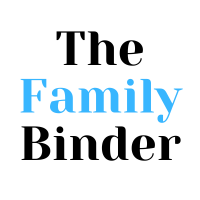Estate planning is essential, yet often overlooked. It’s about ensuring that when you’re no longer around, your family has the guidance and tools they need to carry out your wishes without stress or confusion.
This is where The Family Binder comes in—a comprehensive guide that organizes every aspect of your estate, making it easier for your children to manage when the time comes.
What Is The Family Binder?
The Family Binder is a tool designed to simplify estate planning for families. It’s a physical or digital compilation of all critical documents, financial details, and personal instructions, organized for easy access by your loved ones.

Benefits of Using The Family Binder for Estate Planning
By creating a Family Binder, you’re offering your children clarity and direction, reducing legal and financial complications, and bringing peace of mind to everyone involved. Knowing that everything is organized and accessible helps avoid misunderstandings, delays, and extra costs during an emotional time.

Step 1: Setting Up The Family Binder
- Choose the Format: Decide whether a physical binder, a digital version, or a combination works best for your family.
- Gather Essentials: Start by collecting crucial documents, such as IDs, social security information, and any other paperwork specific to your financial and medical history.
Step 2: Financial Information
To make it easier for your children to handle your finances, include:
- Bank Accounts: Document account numbers and contact details for banks.
- Investments: Include stocks, bonds, retirement accounts, and more.
- Insurance Policies: Note details for life, health, property, and other insurances.
Step 3: Legal Documents
Organize and store all critical legal documents, including:
- Wills and Trusts: Ensure a copy is included, along with the contact information for your attorney.
- Power of Attorney: Document any powers you’ve granted and to whom.
- Living Will: Outline medical directives for unforeseen circumstances.
Step 4: Healthcare and Medical Directives
Healthcare information is vital, especially in emergencies. In your binder, include:
- Healthcare Proxy: Document who will make medical decisions for you.
- Prescription Information: Record ongoing prescriptions and medical history.
- Living Will: Include specific instructions about end-of-life care.
Step 5: Real Estate and Property Information
For properties and real estate, document:
- Deeds and Titles: List all properties, mortgages, and ownership details.
- Rental Properties: Include information on tenants, rental agreements, and property managers if applicable.
Step 6: Personal Belongings and Sentimental Items
- Inventory List: Describe valuable and sentimental items like jewelry, artwork, or family heirlooms.
- Distribution Instructions: Specify who should receive each item.
Step 7: Final Wishes and Funeral Planning
Take time to outline your final wishes. It’s helpful to document:
- Funeral Arrangements: Whether you prefer burial or cremation, and any other specific instructions.
- Memorial Preferences: Include details on music, readings, or religious practices.

Step 8: Preparing Your Children for The Responsibility
It’s crucial to discuss your plans with your children:
- Assign Roles: Decide who will handle specific responsibilities, such as finances or healthcare decisions.
- Open Communication: Allow your children to ask questions and ensure they’re comfortable with their roles.
Step 9: Updating The Family Binder Regularly
An outdated binder can be as problematic as having none at all. Make it a habit to:
- Schedule Updates: Every six months or annually, review the contents.
- Notify Your Family: If there are any changes, communicate them directly to those involved.
Step 10: Additional Resources for Estate Planning
Consider using additional resources to ensure your estate is fully prepared:
- Consult Professionals: Work with legal and financial advisors to review your plan.
- Use Online Tools: There are various online templates and tools to help organize your binder effectively.
FAQs
- Why should I use The Family Binder for estate planning? The Family Binder centralizes all essential information, making it easy for your family to carry out your wishes without confusion.
- How often should I update The Family Binder? Aim to review and update it annually or after significant life events.
- Should I involve my children in creating The Family Binder? Yes, involving them can help ensure they understand the contents and feel prepared.
- Is a digital Family Binder secure? Digital binders can be secure if stored on encrypted devices and shared only with trusted individuals.
- Can a Family Binder replace a will? No, it should complement your legal documents, including a will and trust, not replace them.

Peace of Mind Through Preparation
Creating a Family Binder goes beyond simply organizing paperwork—it’s a lasting gift to your family. This emergency binder PDF not only makes essential information easily accessible but also empowers your loved ones to navigate future transitions with confidence.
By putting everything in order now, you’re providing your family with the reassurance of a clear, reliable roadmap, helping to prevent misunderstandings or conflicts during critical times. This Family Binder is more than just a document; it’s a legacy of care, a resource that offers peace of mind to those who matter most.
Take action today—secure your family’s future with confidence. Use code SAVE20 at checkout for 20% off, because true peace of mind is one decision away.
Download The Family Binder now.

